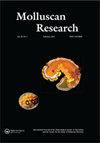盐度对蛏子血淋巴离子浓度的影响及其对鳃和消化腺组织病理学的影响(Solen dactylus von Cosel, 1989);双壳纲,Solenidae)
IF 0.6
4区 生物学
Q3 ZOOLOGY
引用次数: 6
摘要
趾尖梭蛤(Solen dactylus)是西印度洋和波斯湾潮带最常见的剃刀蛤之一。由于高度蒸发和强降雨,这些蛤蜊的栖息地可能受到盐度波动的影响。为了评估它们的适应性,在实验室中,蛤蜊被放置在50升的水箱中,深40厘米的天然基质中,在45 ppt的盐度下保持一周,然后再进行后续实验。然后,他们暴露在5、20、35、45和65 ppt的盐度中三周。在实验开始后1、24、72 h、1周和3周测量血淋巴和水箱水中Na+、Cl -、K+、Ca2+和Mg2+的浓度以及渗透压。血淋巴Na+和Cl -值随外界介质浓度变化,在低盐度时降低,在高盐度时升高。Ca2+、Mg2+和K+离子均表现出一种共同的模式,其趋势与外界环境无关。组织病理学分析显示,在低盐度下,细胞间隙扩大,消化小管胞浆内空泡增加,鳃组织坏死和片层破坏,严重的组织损伤。本文章由计算机程序翻译,如有差异,请以英文原文为准。
Salinity induced alterations in ionic concentration of haemolymph and its effects on histopathology of gills and digestive gland in razor clam (Solen dactylus von Cosel, 1989; Bivalvia, Solenidae)
ABSTRACT Solen dactylus is one of the most common razor clams in the tidal zone in the western Indian Ocean and Persian Gulf. Habitats of these clams may be subject to salinity fluctuations due to high evaporation and heavy rainfall. To assess their adaptation, in the laboratory clams were placed in 50-litre tanks with 40 cm depth of natural substrate and were kept in salinity of 45 ppt for a week before subsequent experiments. They were then exposed to salinities of 5, 20, 35, 45 and 65 ppt for three weeks. Concentrations of Na+, Cl–, K+, Ca2+, and Mg2+, as well as osmolality in the haemolymph and tank water were measured at 1, 24, 72 h, one week and three weeks after the start of the experiment. Haemolymph Na+ and Cl– values followed the concentrations of the external medium so that they decreased at low salinities and increased at high salinities. The Ca2+, Mg2+ and K+ ions all showed a common pattern, and their trend was independent of the external environment. Histopathological analysis showed severe tissue damage at low salinities with expanded intercellular spaces, an increase of intracytoplasmic vacuoles in the digestive tubules, and necrosis and destruction of lamellae in gill tissues.
求助全文
通过发布文献求助,成功后即可免费获取论文全文。
去求助
来源期刊

Molluscan Research
生物-动物学
CiteScore
1.80
自引率
10.00%
发文量
27
审稿时长
>12 weeks
期刊介绍:
Molluscan Research is an international journal for the publication of authoritative papers and review articles on all aspects of molluscan research, including biology, systematics, morphology, physiology, ecology, conservation, biogeography, genetics, molecular biology and palaeontology.
While the scope of the journal is worldwide, there is emphasis on studies relating to Australasia and the Indo-west Pacific, including East and South East Asia. The journal’s scope includes revisionary papers, monographs, reviews, theoretical papers and briefer communications. Monographic studies of up to 73 printed pages may also be considered.
The journal has been published since 1957 (as the Journal of the Malacological Society of Australia until 1993). It is free to members of the Malacological Society of Australasia and the Society for the Study of Molluscan Diversity.
 求助内容:
求助内容: 应助结果提醒方式:
应助结果提醒方式:


